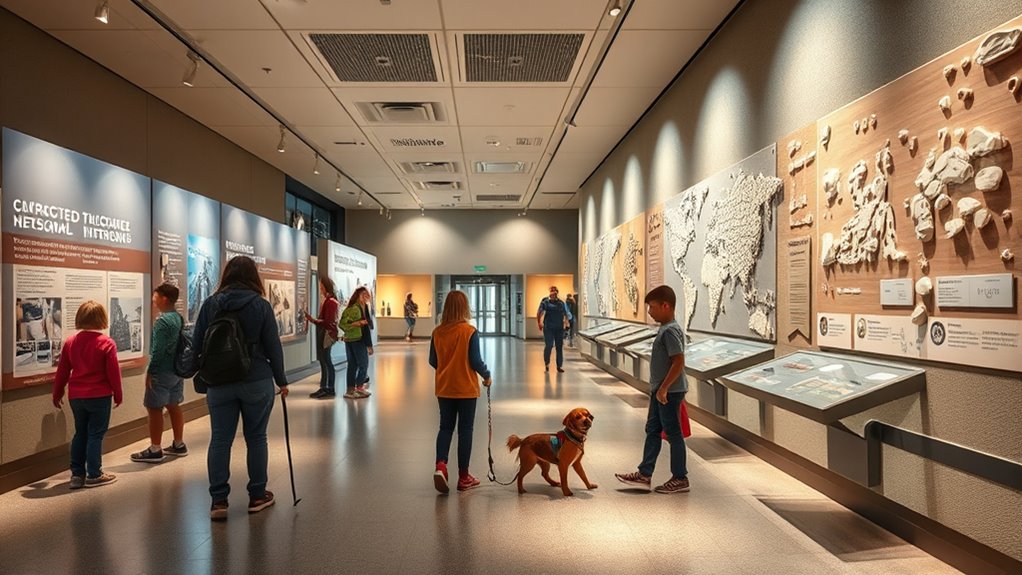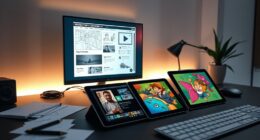To design accessible museums for dual sensory impairments, focus on multisensory experiences that engage touch, sound, scent, and visual cues. Incorporate tactile exhibits, multisensory guides, and adjustable lighting to accommodate diverse needs. Guarantee clear signage and thoughtful layout to facilitate exploration and independence. By blending these elements, you create an inclusive space where visitors can fully enjoy and explore artworks. Continue exploring to discover how these features come together for truly accessible museum experiences.
Key Takeaways
- Incorporate tactile exhibits and models to enable hands-on exploration of artworks.
- Utilize multisensory guides combining audio, tactile, scent, and temperature cues for comprehensive engagement.
- Design clear, accessible layouts with intuitive signage, adjustable lighting, and quiet zones for sensory comfort.
- Provide resources like braille, large print, and audio descriptions to support independent navigation and understanding.
- Ensure staff are trained to assist visitors with dual sensory impairments and promote inclusive, supportive experiences.

Accessible museums are transforming the way people with dual sensory impairments experience art and culture. You now have the opportunity to engage with exhibits in ways that were previously impossible. One of the most effective strategies involves the use of tactile exhibits, which allow you to explore artworks through touch. These exhibits are designed to be safe and accessible, enabling you to feel textures, shapes, and dimensions that convey the artist’s intent. When you can physically interact with the art, you gain a deeper understanding and appreciation that goes beyond visual or auditory information alone. Museums are increasingly incorporating tactile models and textured reproductions, making it possible for you to experience art firsthand, regardless of your sensory limitations.
Accessible museums use tactile exhibits to let you explore and appreciate art through touch and sensory experiences.
In addition to tactile exhibits, multisensory guides are essential tools that enhance your museum experience. These guides combine audio descriptions, tactile maps, and sometimes even scent or temperature cues to create a rich, immersive environment. As you navigate through exhibits, multisensory guides help you form mental images and contextualize what you’re exploring. They are often available in various formats, such as braille, large print, or audio, ensuring you can choose the method that best suits your needs. With these guides, you no longer have to rely solely on visual cues; instead, you can engage multiple senses simultaneously, which makes the experience more inclusive and meaningful.
Designing a museum with accessibility in mind means more than just adding tactile exhibits and multisensory guides. It involves thoughtful layout planning, clear pathways, and signage that are easy to understand and follow. When you visit, you should feel confident that you can explore freely without obstacles. Museums might also incorporate adjustable lighting, soundproof areas, or quiet zones to accommodate sensory sensitivities. These features collectively create an environment where you can focus on the art without feeling overwhelmed or excluded.
Ultimately, the goal of designing accessible museums for dual sensory impairments is to empower you to enjoy cultural experiences fully. Tactile exhibits and multisensory guides serve as bridges, connecting you with the art and history in a way that respects your unique needs. By prioritizing these strategies, museums open their doors wider, inviting you to participate actively and independently. This inclusive approach not only enriches your experience but also sets a standard for how cultural institutions can serve everyone, regardless of sensory abilities. Engaging with resources and tools, such as tactile models and multisensory guides, helps ensure that museum experiences are truly inclusive for all visitors.
Frequently Asked Questions
How Can Technology Enhance Museum Accessibility for Dual Sensory Impairments?
Technology can substantially improve museum accessibility for dual sensory impairments by using assistive technology and interactive exhibits. You can incorporate tactile displays, audio descriptions, and visual enhancements to create an inclusive environment. Interactive exhibits allow visitors to engage actively, while assistive technology provides personalized support, making the experience more meaningful. These innovations help break down barriers, ensuring everyone can enjoy and learn from the exhibits equally.
What Training Do Staff Need to Support Visitors With Dual Impairments?
Think of staff training as the backbone of great support. You need to guarantee your team understands disability awareness and how to assist visitors with dual impairments effectively. This involves practical training on communication methods, sensory-friendly approaches, and emergency procedures. By doing so, your staff can provide compassionate, informed support, making the museum experience inclusive and enriching for all visitors, regardless of their sensory needs.
How Can Museums Involve Visually and Hearing-Impaired Visitors in Design?
You can involve visually and hearing-impaired visitors in design by actively seeking their input through surveys and focus groups. Incorporate tactile exhibits that allow hands-on engagement, and integrate sign language options for audio content. This approach guarantees the museum’s features meet their needs, making the experience more inclusive and meaningful. Listening to their feedback helps you create a space that truly welcomes and accommodates all visitors.
What Funding Options Are Available for Retrofitting Existing Museum Spaces?
Sure, because retrofitting your museum must be a breeze, right? Luckily, you can tap into grant opportunities and government funding designed to boost accessibility. These resources often cover renovations for dual sensory impairments, making your space inclusive without breaking the bank. Don’t miss out—apply early, follow the guidelines diligently, and turn your museum into a welcoming haven for all visitors, no matter their needs.
How Do Cultural Differences Influence Accessibility Strategies for Dual Impairments?
Cultural perceptions and accessibility norms shape how you approach dual sensory impairments in museums. You need to comprehend local values and expectations, which influence what accommodations are considered appropriate. By respecting cultural differences, you can develop inclusive strategies that resonate with visitors’ backgrounds. This approach ensures your accessibility efforts are effective, respectful, and welcoming, ultimately making your museum a more inclusive space for everyone, regardless of their sensory impairments.
Conclusion
As you walk through a museum designed for everyone, you realize that every detail, from tactile exhibits to sound cues, was created with care. It’s no coincidence that these spaces open your eyes to new perspectives, reminding you that accessibility benefits us all. When you see someone truly connect with art despite their challenges, it’s a powerful reminder: inclusive design isn’t just thoughtful, it’s life-changing. And in that moment, you feel the profound impact of genuine accessibility.











